Kata of Shinto Muso-ryu
神道夢想流
Shinto Muso-ryu is a well structured and comprehensive martial system of Sword and Staff use. And though the sheer number of kata can appear daunting, in reality the groups of kata develop a student in a step-wise progression of techniques and combative strategies.
These groups of kata mesh like fine gears in a way that is astounding! SMR has not remained static over the years, these kata we study today are the result of literally hundreds of years of refinement and growth by the military police of the Kuroda in Kyushu, Japan. All traditional SMR kata are done in pairs (Sword vs. Staff – Uchidachi vs. Shijo), there are few solo exercises and no solo kata.
Regarding swordsmanship (Kenjutsu), it should be clear to even the casual observer that a high level of skill with the sword is necessary to produce a skilled jojutsu exponent.
The reality is that the kenjutsu studied and used within Shinto Muso ryu is rich, effective, and copious. Students spend almost the same amount of training time with the sword as they do with the Jo, and as time goes by the more experienced students will spend even more time learning to effectively use the sword.
Kihon & Seitei Kata
Omote
Chudan
Ran’ Ai
Kage
Samidare
Gohon no Midare
Okuden / Shiai Kuchi
Gokui Hiden / Go Muso no Jo
Heiden Bujutsu (or Fuzoku Ryuha)
Shinto Ryu Kenjutsu
Uchida Ryu Tanjojutsu
Isshin Ryu Kusarigamajutsu
Ikkaku Ryu Juttejutsu
Kihon 基本 &
Seitei Kata 制定形 of modern Jodo 杖道
These Kihon and Kata were created by Shimizu Takaji, along with Otofuji Ichizo and a committee of Kendo Association representatives in the 1950’s & 60s. Shimizu Takaji, through his instructing of the Tokyo Police, recognized the need for a method of teaching Jodo that accommodated much larger class sizes than are found in traditional Shinto Muso Ryu dojo. Where small groups of students receiving one-one-one instruction is the norm.
The result was the Zen Nihon Ken Renmei (ZNKR) Seitei Jodo system containing twelve forms (kata) and twelve basic techniques (kihon). This could be considered a ‘compact’ Jodo system, taught as a stand-alone training curriculum, and often taught in Kendo dojos.
Both the basic techniques and forms are drawn primarily from the koryu martial art of Shinto Muso-ryu, and are strictly speaking, not part of traditional Shinto Muso Ryu Jo kata.
These kata were chosen from the three first series of SMR: Omote, chudan and Ran’ Ai as they were seen to best represent the art. Ten of these kata were taken from the existing SMR kata but with minor modifications as to better suit the requirements of the Kendo Federation.
These modifications often involve timing, distances, targets, and overall movements to make the kata a bit safer. And to reflect the Kendo predisposition for ‘squared’ postures and body alignment, and relatively taller stances.
The two other kata was created specifically for the new Seitei Jodo system (Suigetsu & Shamen) and was not part of the original SMR-system. Seitei Jodo is today taught as a part of the Zen Nihon Kendo Renmei (All Japan Kendo Federation).
Today thousands of people study Seitei Jodo and engage in kata competitions organized by the overarching Kendo Federation (ZNKR), and may earn black belt ranks (up to Hachidan / 8th dan). This is one of the largest differences between traditional Shinto Muso Ryu Jo and Seitei Jodo. Some SMR dojo participate in the Kendo Federation examinations and competition, in addition to the traditional SMR kata study.
Traditional SMR has no competitions or black belt rankings. But many traditional SMR dojo use the Kihon and Seitei Kata as a way to introduce the Jo/Sword fundamentals to new students.
The Shobukan Dojo does use Kihon and Seitei Kata for training purposes, but does not participate in the ZNKR examinations or competitions.
| 本手打 | Honte Uchi | Normal hand strike |
| 逆手打 | Gyakute Uchi | Reverse hand strike |
| 引落打 | Hiki Otoshi Uchi | Pull, drop, strike |
| 返突 | Kaeshi Zuki | Return & thrust |
| 逆手突 | Gyakute Zuki | Reverse thrust |
| 巻落 | Maki Otoshi | Wrap & drop |
| 繰付 | Kuri Tsuke | Spin, attach to, pin |
| 繰放 | Kuri Hanashi | Spin & release |
| 体当 | Tai Atari | Body strike |
| 突外打 | Tsuki Hazushi Uchi | Stab to outside & strike |
| 胴払打 | Do Barai Uchi | Strike to body/thoracic area |
| 体外打 | Tai Hazushi Uchi | Evade body outside strike |
| 著杖 | Tsuki Zue | Arriving at/with the Jo |
| 水月 | Suigetsu | Moon on Water |
| 引提 | Hissage | To pull along |
| 斜面 | Shamen | Diagonal strike to head |
| 左貫 | Sakan | Pierce left side |
| 物見 | Monomi | Scout, patrol, lookout, watchtower |
| 霞 | Kasumi | Hidden mist |
| 太刀落 | Tachi Otoshi | Drop sword down |
| 雷打 | Rai Uchi | Strike like lightning bolt |
| 正眼 | Seigan | Aiming at eyes |
| 乱留 | Midare Dome | Stop chaos |
| 乱合 | Ran' Ai | Join/bind chaos |
Omote 表
This is the first set of actual kata in Shinto Muso Ryu. It should be considered a tool for teaching the fundamentals (these existed before Kihon & Seitei Kata). Shimizu Takaji said these kata should be used to develop proper body movement, coordination/manipulation, and effective operation of the Jo. Timing of movements are not fast, but regular and measured with an even tempo. Keep in mind that in years past a student might reach Kage or Samidare before learning the Sword side of each kata.
| 太刀落 (前・後) | Tachi Otoshi (zen/go) | Drop the sword down |
| 鍔割 | Tsuba Wari | Break the Tsuba |
| 著杖 | Tsuki Zue | Arriving at/with the Jo |
| 引提 | Hissage | Pull & carry along |
| 左貫 | Sakan | Pierce left side |
| 右貫 | Ukan | Pierce right side |
| 霞 | Kasumi | Hidden in mist |
| 物見 | Mononi | Scout, patrol, watchtower, lookout |
| 笠の下 | Kasa no Shita | Under a hat |
| 一礼 | Ichi Rei | Initial formality |
| 寝屋ノ内 | Neya no Uchi | In the bedroom |
| 細道 | Hoso Michi | Narrow road |
Chudan 中段
The second set of SMR kata, Chudan seeks to take what a student has learned in Omote and build upon this with increased speed and fluidity. Time to get out of the comfort zone and challenge the ability to perform the basic movements under more dynamic conditions. This can feel/look a bit rushed, and it might be. But with this comes the potential to expose more weakness in Jo technique. Then identify those weaknesses and rectify them.
| 一力 | Ichi Riki | Unified strength |
| 押詰 | Oshi Zume | Push & press close |
| 乱留 (前・後) | Midare Dome (zen/go) | Stop chaos |
| 後杖 (前・後) | Ushiro Zue (zen/go) | The staff from behind |
| 待車 | Taisha | Waiting vehicle |
| 間込 (前・後) | Ken Gome (zen/go) | Step through a gap |
| 切懸 | Kiri Kake | Cut & suspend |
| 真進 | Shin Shin | True advance |
| 雷打 | Rai Uchi | Strike like thunder |
| 横切留 (前・後) | Yoko Giri Dome (zen/go) | Stopping a side cut |
| 払留 | Harai Dome | Brush away & stop |
| 清眼 | Seigan | Pure eye |
Ran’ Ai 乱合
This set of kata is not found in the traditional SMR scrolls conferred to students who have earned them. But it appears to have been developed in the Bakumatsu era (1850-1867)[2]. It incorporates and synthesizes techniques from Omote and Chudan in a long, dynamic set of movements. Performed with both the long and short swords.
| 乱合 - 大太刀 | Ran' Ai - Odachi | Join/bind chaos |
| 乱合 - 小太刀 | Ran' Ai - Kodachi |
| 太刀落 | Tachi Otoshi | Drop sword down |
| 鍔割 | Tsuba Wari | Split the tsuba |
| 著杖 (前・後) | Tsuki Zue (zen/go) | Arrive at/with the Jo |
| 引提 | Hissage | Pull & carry along |
| 左貫 | Sakan | Pierce left side |
| 右貫 | Ukan | Pierce right side |
| 霞 | Kasumi | Hidden in mist |
| 物見 | Mononi | Scout, patrol, watchtower, lookout |
| 笠の下 | Kasa no Shita | Under the hat/umbrella |
| 一礼 (前・後) | Ichi Rei (zen/go) | Initial formality |
| 寝屋ノ内 (前・後) | Neya no Uchi (zen/go) | In the bedroom |
| 細道 | Hoso Michi | Narrow road |
| 一文字 | Ichimonji | Straight line |
| 十文字 | Jumonji | Cross shaped |
| 二刀小太刀落 | Nito Kodachi Otoshi | Two swords, drop short sword |
| 微塵(前・後) | Mijin (zen/go) | Delicate speck/dust, insignificant |
| 眼つぶし | Gan Tsubushi | Crush eyeball/sight |
Gohon no Midare
本の乱
Developed by Shimizu Takaji around 1940, it is not a part of the traditional SMR kata. But seems to be practiced by most SMR groups today. It is said that Shimizu Takaji felt this set was ‘not quite finished’. Thus you may see some variations between different SMR groups, but fundamentally these kata are the same. It is said this group of kata is a synthesis of Omote/Chudan/Ran’ Ai/Kage. [2]
| 太刀落の乱 | Tachi Otoshi no Midare | Dropping sword down chaos |
| 左貫の乱 | Sakan no Midare | Pierce left side chaos |
| 間込の乱 | Ken Gome no Midare | Stepping between the chaos |
| 霞の乱 | Kasumi no Midare | Mist chaos |
| 斜面の乱 | Shamen no Midare | Strike side of head chaos |
| 先勝 | Sengachi |
| 引捨 | Hiki Sute |
| 小手搦 | Kote Garami |
| 十手 | Jutte |
| 打分 | Uchi Wake |
| 水月 | Suigetsu |
| 左右留 | Sayu Dome |
| 小手留 | Kote Dome |
| 突出 | Tsuki Dashi |
| 打付 | Uchi Tsuke |
| 見返 | Mi Kaeri |
| あうん | Aun |
| 闇 討 | Yami Uchi |
| 夢 枕 | Yume Makura |
| 村 雲 | Mura Kumo |
| 稲 妻 | Inazuma |
| 導 母 | Dobo |
Heiden Bujutsu 併伝武術 (associated martial arts that are carried along with…. sometimes referred to as:
Fuzoku Ryuha 付属流派
(Assimilated Martial Arts)
Over time Shinto Muso Ryu incorporated other weapon systems into the overall curriculum. Driven mostly by the Kuroda Military Police, these other weapon systems were included in a way that reflected movements and principles found in SMR core kata. These groups of kata are taught to students gradually, after they have reached a certain level of proficiency in the primary SMR Jo kata.
Included are: Shinto Ryu Kenjutsu – Swordsmanship, Uchida Ryu Tanjo Jutsu – short staff, Isshin Ryu Kusarigama Jutsu – Sickle & Chain, Ikkaku Ryu Jutte Jutsu – truncheon, Ittatsu Ryu Hojojutsu – prisoner restraint with ropes
Shinto Ryu Kenjutsu
神道流剣術
A Japanese sword, through Kenjutsu, is the primary weapon used against a person wielding a Jo. Thus its emphasis is paramount. The reality is that Kenjutsu skills are taught all through the regular SMR curriculum. It is said that ‘a strong swordsman will help build a good Jo exponent’. Also, Kenjutsu is the only Fuzoku Ryuha actually listed in the SMR mokuroku. *Some SMR groups use ‘Ai Sun’ instead of ‘Ai Suri’*.
| 合摺 (左•右) | Ai Suri (hidari / migi) |
| 鷲 | Jyu |
| 乳払 | Chibarai |
| 左輪 | Sarin |
| 受返 | Uke Gaeshi |
| 二刀合 | Nito Ai |
| 摺込 | Suri Komi |
| 咽中 | Inchu |
| 受流 | Uke Nagashi |
| 三受留 | Miuke Dome |
| 突出 | Tsuki Dashi |
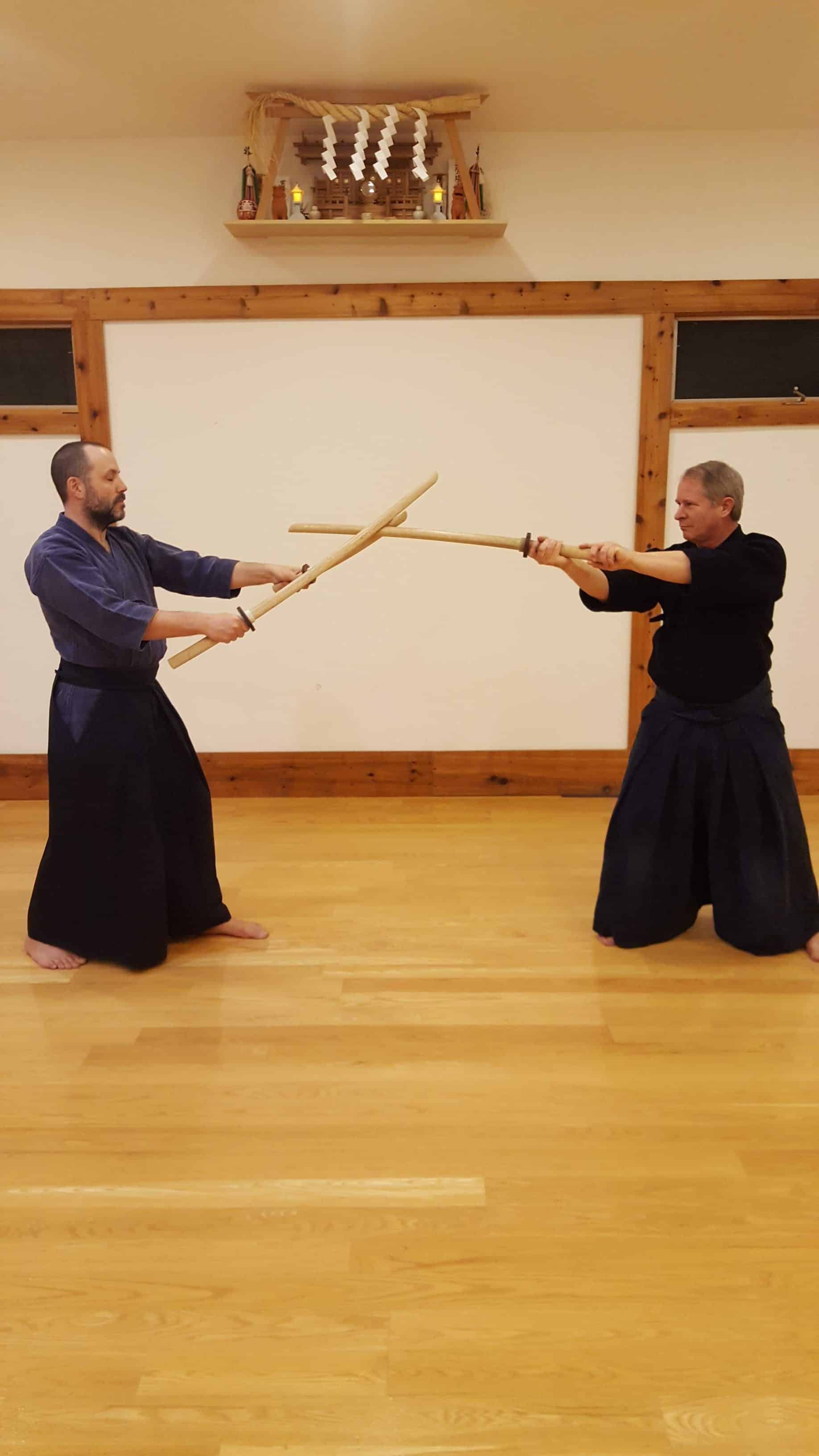
Uchida Ryu Tanjojutsu
内田流短杖術
(short staff/walking cane)
The Tanjo is a walking staff/cane-length weapon. A relatively new addition to the overall SMR curriculum is, of course, based on the movements of the longer Jo. Uchida Ryogoro incorporated these European cane techniques into SMR sometime around 1885. [5]
| 小手打(左) | Kote Uchi (hidari) |
| 小手打(右) | Kote Uchi (migi) |
| 捨身 | Sutemi |
| 繰付 | Kuri Tsuke |
| 後杖 | Ushiro Zue |
| 水月(左) | Suigetsu (hidari) |
| 水月(右) | Suigetsu (migi) |
| 斜面(左) | Shamen (hidari) |
| 斜面(右) | Shamen (migi) |
| 拳砕 | Kobushi Kudaki |
| 脛砕 | Tsune Kudaki |
| 入 身 | Irimi |

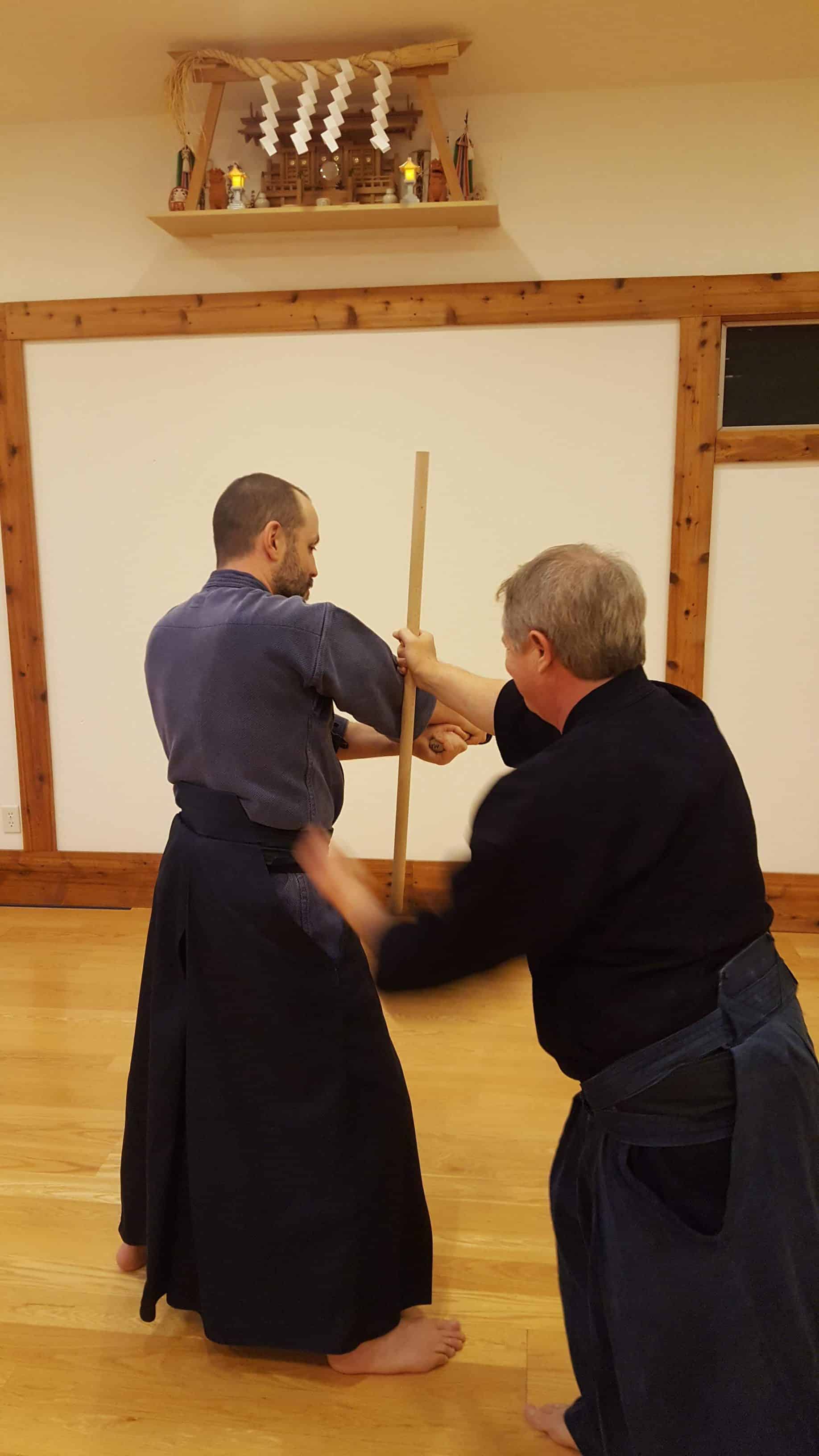
Isshin Ryu Kusarigamajutsu
一心流鎖鎌術
(double-edged sickle & weighted chain)
The Kusarigama is sickle and chain weapon thought to have been incorporated into SMR during the 17th century. It is effective as a ‘distance’ weapon. A practical weapon for use in open areas, Kuroda Police found value and utility in this tool for law enforcement. Originally a double-edged blade, wooden handle with metal hand-guard, and a weighted chain. Today a wooden weapon and hemp rope/leather bag(fundo) is used for training. Training is divided into three sets of kata: Omote, Ura, Okuden. [6].
Omote & Ura (表 & 裏)
| 居敷 | Ishiki |
| 添身 | Soemi |
| 羽返 | Ha Gaeshi |
| 無眼 | Mugan |
| 十文字 | Jumonji |
| 振込(前) | Furi Komi (zen) |
| 振込(後) | Furi Komi (go) |
| 磯之浪 | Iso no Nami |
| 巻落 | Maki Otoshi |
| 三所詰 | Midokoro Zume |
| 浮船 | Uki Fune |
| 袖搦 | Sode Garami |
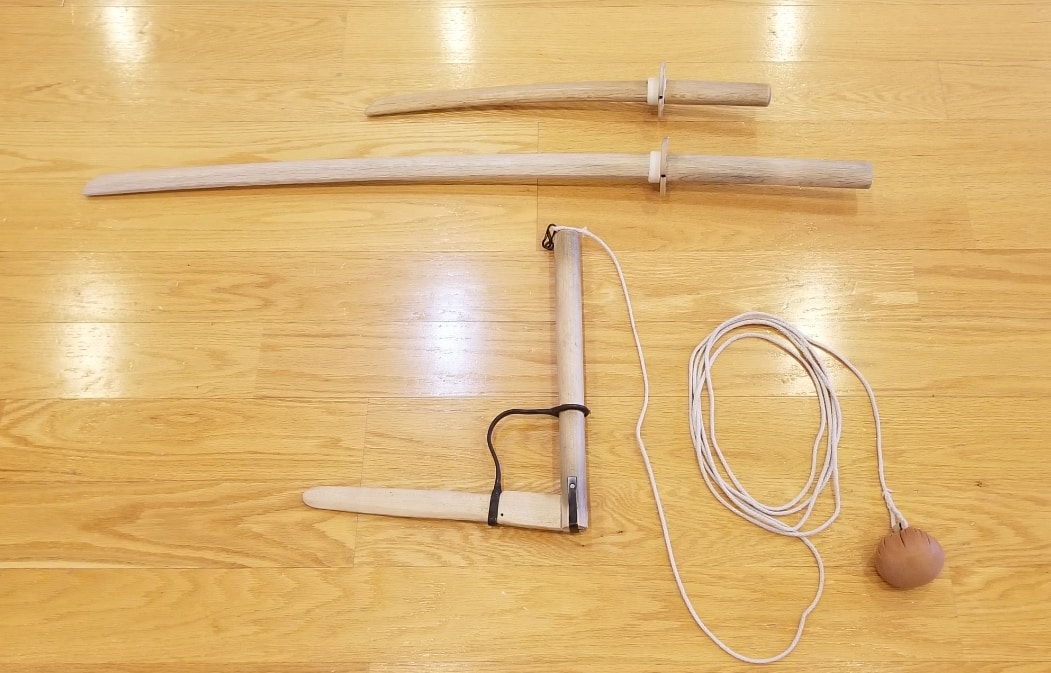
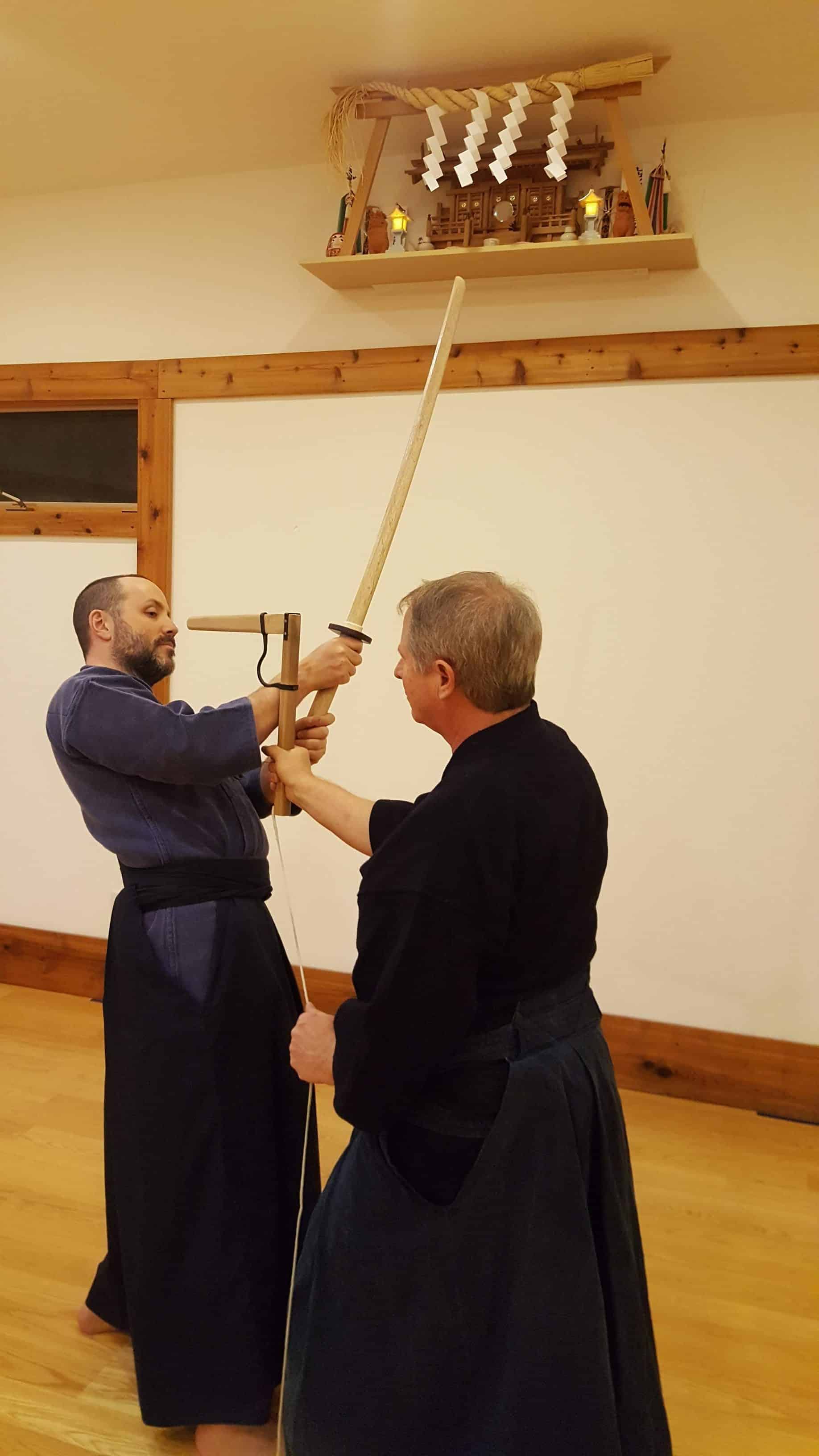
Okuden 奥伝
| 前 | Zen/Mae |
| 後 | Go/Ushiro |
| 左 | Sa/Hidari |
| 右 | Yu/Migi |
| 上 - 槍合せ | Ue - Yari Awase |
| 下 - 槍合せ | Shita - Yari Awase |
Ikkaku Ryu Juttejutsu
一角流十手術
(truncheon)
The (jutte) is a baton made of iron with a small tine or prong fitted just above the handle. The gripspace of the handle is wrapped with a cord that hangs down from underneath the handle with a tassle at the end. The jutte was mainly used by police-forces of the Edo-period of Japan and is known to have had over 200 variations.[4]
A typical tessen of the Edo-period (1603-1868). This weapon is used in tandem with the jutte in some forms of Ikkaku-ryu
Ikkaku-ryu fields a truncheon about 45 cm in length with a weight of about 550 grams.[4] It has a smooth shaft ending in a handle wrapped in a coloured cord ending with a hanging tassel. A small tine is attached just above the grip. Originally the colour of the wrapping-cord indicated the social level of the wielder.[4] The original design of the Ikkaku-ryu jutte had a hexagonal shaft cross-section with the tine attached to one of the corners instead of the flat surface.[4] The inside of the tine was also sharpened which enabled the wielder to use it for cutting if applicable.[4]
The fan (tessen) used in Ikkaku-ryu is about 30 cm in length.[4] The fan was designed to look like a regular folding-fan carried by samurai and other nobles in the samurai-era when they did not have access to their swords.[4] These special tessens were in some cases either made totally of iron or had iron-edges thus enabling it to be a small self-defence weapon if required.
The modern Ikkaku-ryu system fields 24 training-forms (kata) divided between 2 series called Omote and Ura. Some of the kata uses a war fan (Tessen)[4] in tandem with the jutte. The forms of the Omote and Ura-series share the same name but are different in application. [7]
Omote & Ura (表 & 裏)
| 右劔 | Uken |
| 左劍 | Saken |
| 残劍 | Zanken |
| 蹴上劍 | Ke Age Ken |
| 一亂劔 | Ichi Ran Ken |
| 入身劍 | Irimi Ken |
| 一風劔 | Ippu Ken |
| 目當劔 | Me Ate Ken |
| 有當劔 | Uto Ken |
| 五倫劔 | Gorin Ken |
| 一聲劔 | Issei Ken |
| 霞劍 | Kasumi Ken |
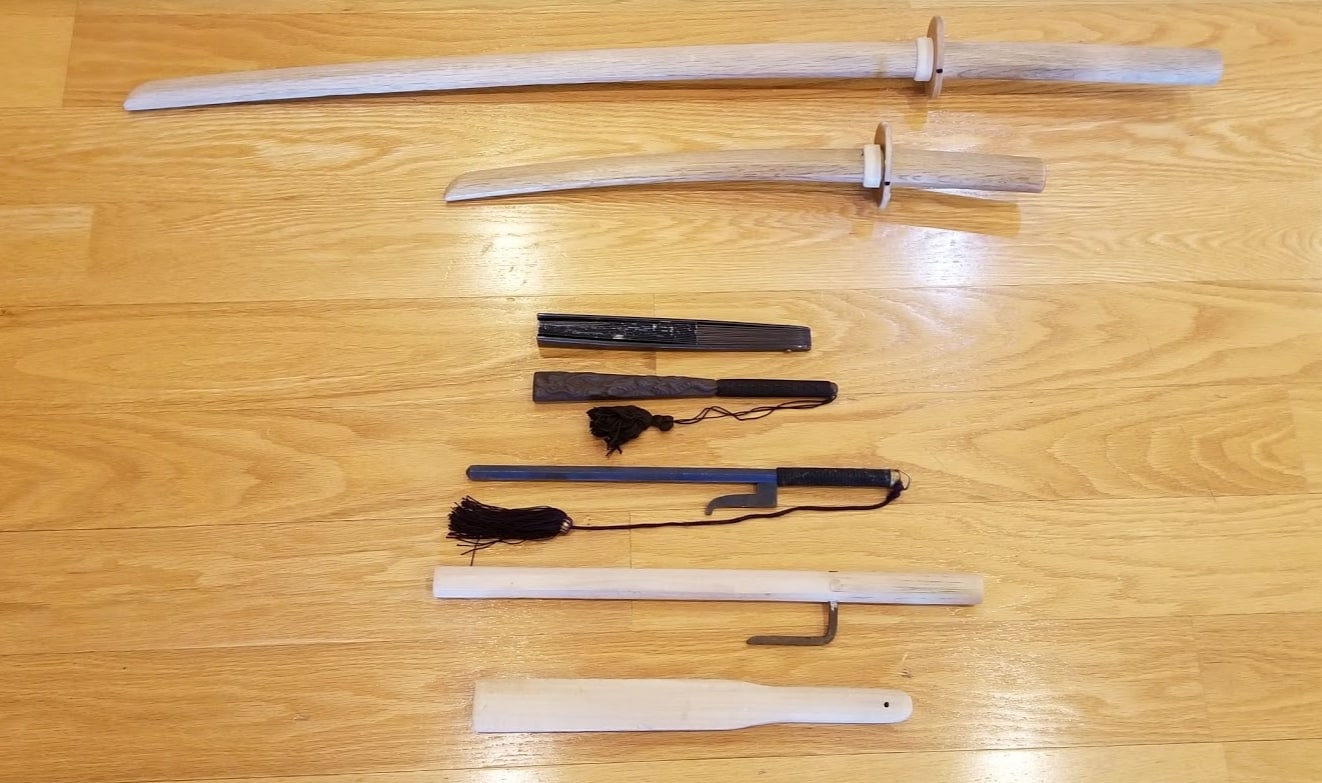
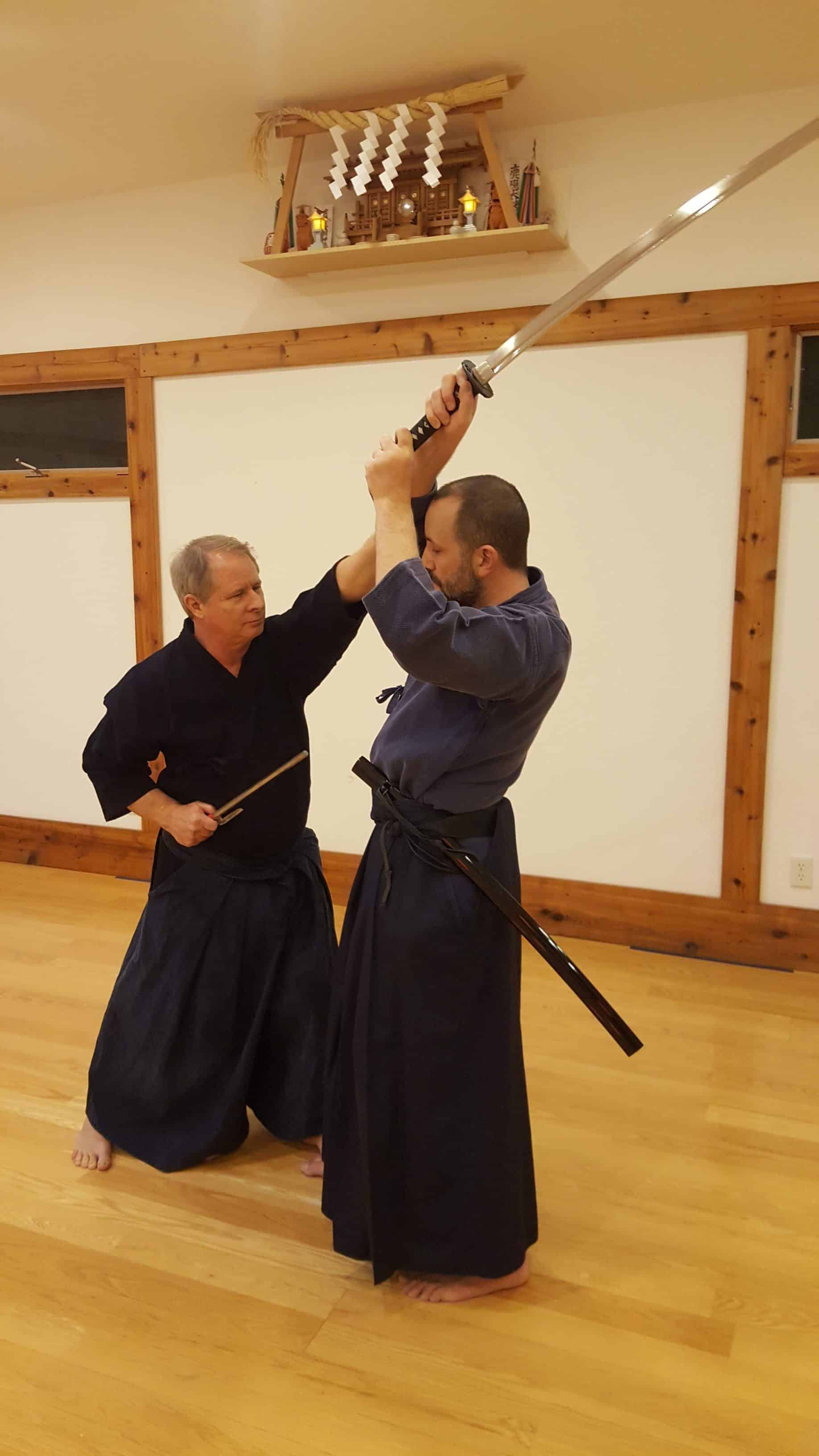
References
1. Jodo of Zen Nihon Kendo Renmei
2. Shinto Muso Ryu Kata
3. Matsui, Kenji. 1993. The History of Shindo Muso Ryu Jojutsu, translated by Hunter Armstrong (Kamuela, HI: International Hoplological Society)
4. Krieger, Pascal – Jodô – la voie du bâton / The way of the stick (bilingual French/English), Geneva (CH) 1989, ISBN 2-9503214-0-2
5. Uchida Ryu Tanjo Jutsu
6. Isshin Ryu Kusarigama Jutsu
7. Ikkaku Ryu Jutte Jutsu
